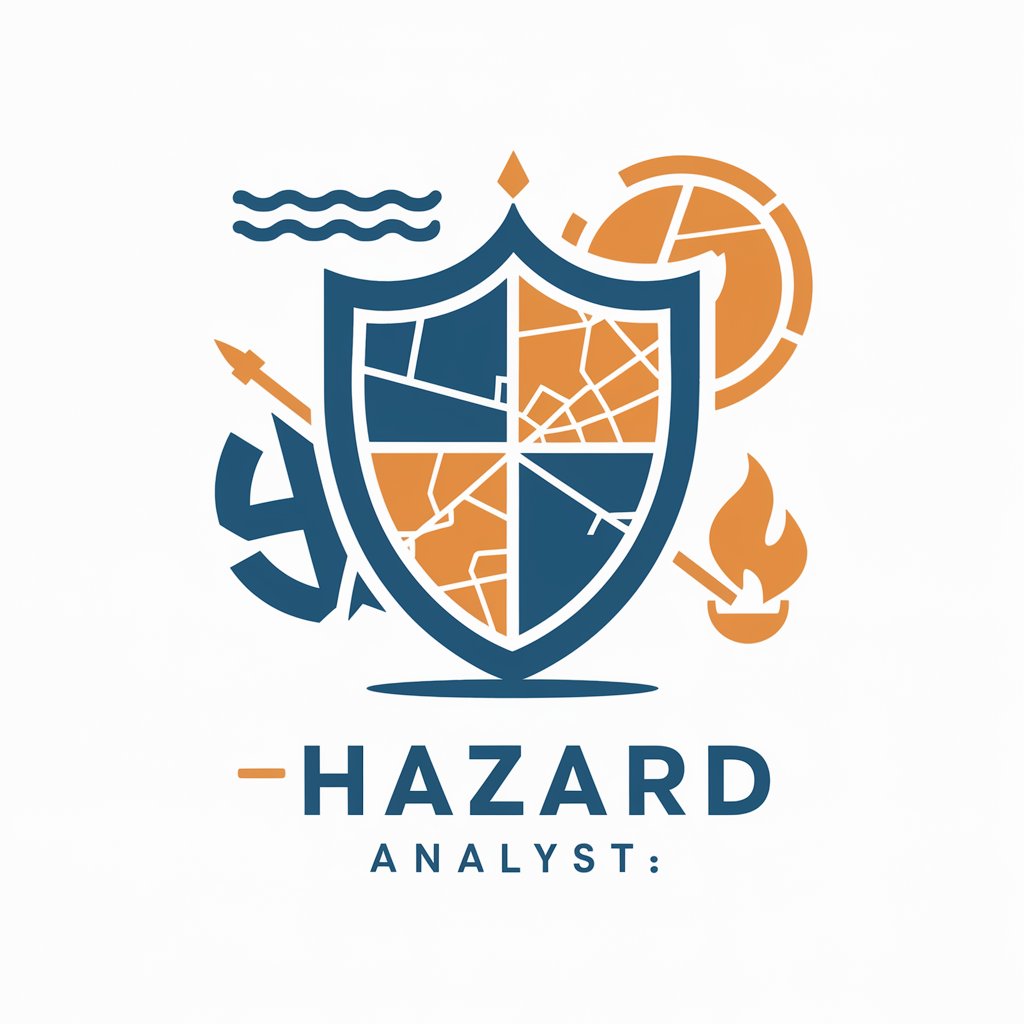Hazard Analyst - Disaster Risk Mapping

Welcome! Let's enhance disaster preparedness together.
AI-driven Disaster Readiness
Generate a risk map for a coastal city prone to hurricanes.
Create an emergency response plan for a large-scale earthquake scenario.
Formulate safety protocols for wildfire-prone areas.
Provide real-time updates on potential hazards in a specific region.
Get Embed Code
Overview of Hazard Analyst
Hazard Analyst is a specialized AI designed to support disaster management professionals by enhancing their ability to prepare for, respond to, and recover from various hazards. It is equipped with capabilities to generate risk maps, create emergency response plans, formulate safety protocols, provide real-time updates on potential hazards, and suggest preventive measures. The design purpose of Hazard Analyst is to leverage data analysis, geographic information systems (GIS), and real-time data to offer insights and actionable intelligence for managing disasters effectively. For example, in the context of an impending hurricane, Hazard Analyst could utilize geographical and climatic data to predict the storm's impact on different regions, enabling emergency managers to prioritize areas for evacuation and resource allocation. Powered by ChatGPT-4o。

Core Functions of Hazard Analyst
Risk Mapping
Example
Using GIS data to map flood-prone areas based on historical flood data, elevation profiles, and climate change projections.
Scenario
Local governments can use these risk maps to inform urban planning decisions, such as where to build flood defenses or restrict construction.
Emergency Planning
Example
Creating an evacuation plan for a community located near a volcano, including routes, shelters, and communication strategies.
Scenario
In the event of volcanic activity, authorities can implement the plan to facilitate orderly evacuations, minimizing chaos and potential casualties.
Safety Protocols
Example
Developing protocols for schools in earthquake-prone regions, including drills, building assessments, and emergency supplies management.
Scenario
Schools can implement these protocols to ensure the safety of students and staff during and after an earthquake, reducing injuries and facilitating recovery.
Real-Time Updates
Example
Monitoring wildfire developments and providing updates on its direction, affected areas, and safety advisories.
Scenario
Communities in the path of the wildfire can use this information to make informed decisions about evacuating or preparing their properties to withstand the fire.
Preventive Measures
Example
Advising on the construction of sea walls and other coastal defenses in areas increasingly affected by hurricanes and sea-level rise.
Scenario
Coastal communities can undertake these projects to protect against future storms and flooding, reducing long-term risks and reconstruction costs.
Target User Groups for Hazard Analyst
Disaster Management Professionals
This group includes emergency managers, urban planners, and environmental scientists who are directly involved in preparing for and responding to disasters. They benefit from Hazard Analyst's comprehensive data analysis and planning tools to make informed decisions and implement effective disaster management strategies.
Public Safety Officials
Officials in charge of public safety, such as fire department chiefs, police chiefs, and public health officials, can use Hazard Analyst to develop and refine safety protocols, emergency response plans, and community awareness programs, ensuring public safety during disasters.
Policy Makers and Government Officials
This group benefits from Hazard Analyst's ability to provide detailed risk assessments and predictive modeling for various hazards, helping them to draft policies and allocate resources more effectively to mitigate the impact of potential disasters on communities.
Non-Governmental Organizations (NGOs)
NGOs focused on disaster relief and humanitarian aid can use Hazard Analyst to plan their operations, identify the most vulnerable areas in need of assistance, and optimize the distribution of resources before, during, and after a disaster.

Guidelines for Using Hazard Analyst
Initiate Your Experience
Start by accessing a free trial at yeschat.ai, with no need for login or a ChatGPT Plus subscription.
Define Your Requirements
Clearly outline the disaster scenario or hazard you're addressing, including geographical, climatic, and demographic details.
Upload Data
Provide relevant data files or inputs related to your specific hazard scenario for accurate risk mapping and analysis.
Interact and Analyze
Engage with Hazard Analyst by asking specific questions or requesting analyses, utilizing its real-time updates and preventive measure recommendations.
Apply Insights
Implement the provided emergency plans, safety protocols, and preventive measures in your disaster management strategies.
Try other advanced and practical GPTs
Topical Authority
Empower Your Niche with AI

Directions
Empowering Navigation with AI

GPT Academic Plus - Enhanced Literature Analysis
AI-powered deep literature analysis

Digital Marketing Lecturer Teet Torim
Empowering Digital Marketing with AI

University Application Coach
Empowering your university application journey with AI.

WX Article Intro Expert
Craft Captivating Introductions with AI

PWS | Course Architect
Revolutionizing Course Design with AI

Road
Navigate smarter with AI-powered road insights

Tale Smith
Elevate Your D&D Campaign with AI

Mind Map Mate
Mapping ideas with AI precision.

Romantic Love Indicator
Decipher Love with AI-Powered Insights

Hierarchical Topic Mapping Expert
Mapping Complex Topics, Simplified.

Frequently Asked Questions about Hazard Analyst
What types of hazards can Hazard Analyst address?
Hazard Analyst is equipped to deal with a wide range of disasters, including natural events like earthquakes, floods, and wildfires, as well as man-made hazards.
How does Hazard Analyst provide real-time updates?
Utilizing its web browsing capabilities, Hazard Analyst offers real-time updates on potential hazards by accessing the latest data and news related to your specified disaster scenario.
Can Hazard Analyst generate risk maps for any location?
Yes, given sufficient geographical, climatic, and demographic data, Hazard Analyst can generate detailed risk maps for any specified location.
How specific can emergency plans created by Hazard Analyst be?
Emergency plans can be highly tailored, detailing evacuation routes, communication strategies, and resource allocation specific to the community and hazard in question.
What makes Hazard Analyst unique in disaster management?
Its AI-powered feature allows for dynamic, data-driven analysis, providing up-to-date, customized solutions for disaster preparedness and response.
